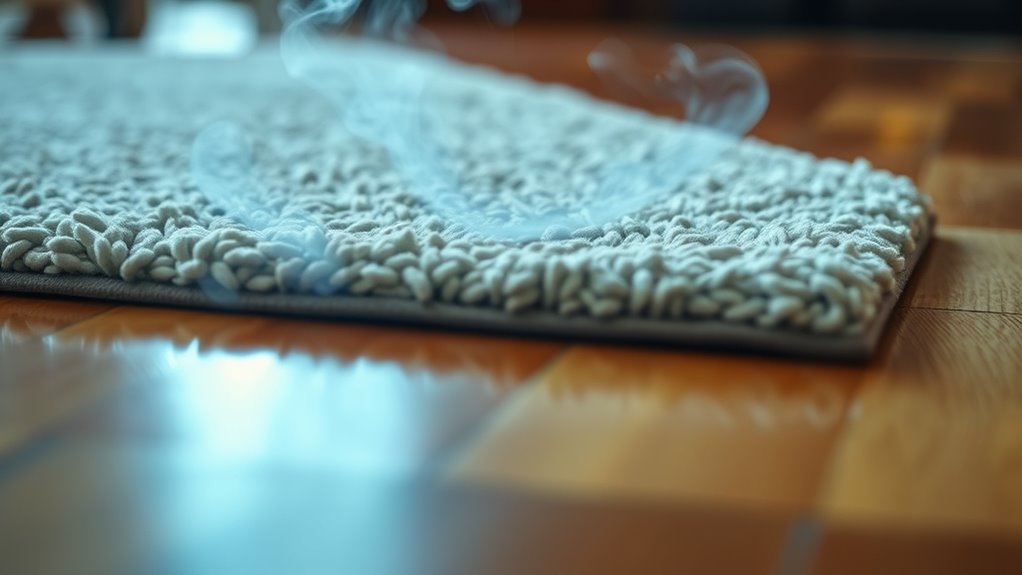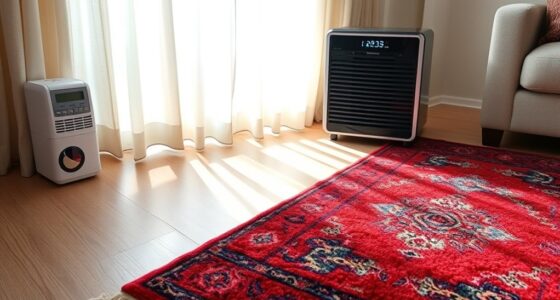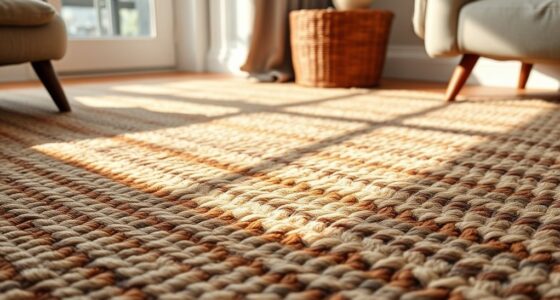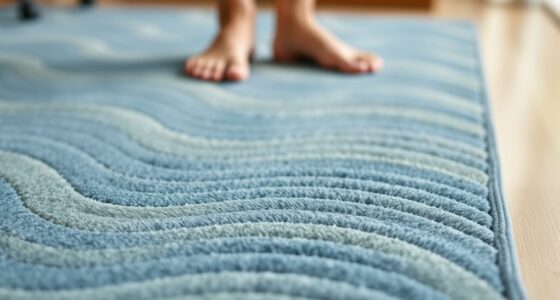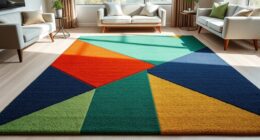Long-term off-gassing of VOCs from rug pads happens when chemicals like adhesives, binders, and manufacturing solvents slowly evaporate into the air over months or even years. Synthetic materials such as rubber, foam, or PVC tend to emit these gases longer than natural options. This ongoing release can cause health issues, especially for sensitive individuals. If you want to learn how to reduce exposure and choose safer options, keep exploring further.
Key Takeaways
- VOCs in rug pads originate from manufacturing chemicals like adhesives, binders, and synthetic materials, leading to prolonged off-gassing.
- Off-gassing can last months to years, with synthetic and chemically treated materials emitting VOCs for extended periods.
- Signs of long-term VOC off-gassing include persistent chemical odors and respiratory irritation in indoor spaces.
- Proper ventilation, air purification, and selecting natural, low-emission materials can significantly reduce long-term VOC exposure.
- Certifications such as GreenGuard and OEKO-TEX indicate rug pads with lower VOC emissions and healthier indoor air quality.
What Are VOCs and Why Do They Off-Gas?

VOCs, or volatile organic compounds, are chemicals that easily evaporate into the air at room temperature. When you install a rug pad, these compounds can be released over time, especially if the materials are synthetic. Off-gassing occurs because many manufacturing processes involve chemicals that aren’t fully bound in the material. As the rug pad warms or is exposed to air, these chemicals vaporize and become airborne. This process can happen gradually, sometimes lasting for months or even years. You might notice a chemical smell or experience respiratory irritation, especially if you’re sensitive. Understanding why VOCs off-gas helps you recognize the importance of choosing safer, low-emission rug pads to improve indoor air quality and reduce potential health risks. High-pressure applications in manufacturing can contribute to increased VOC emissions during production.
Common Sources of VOCs in Rug Pads
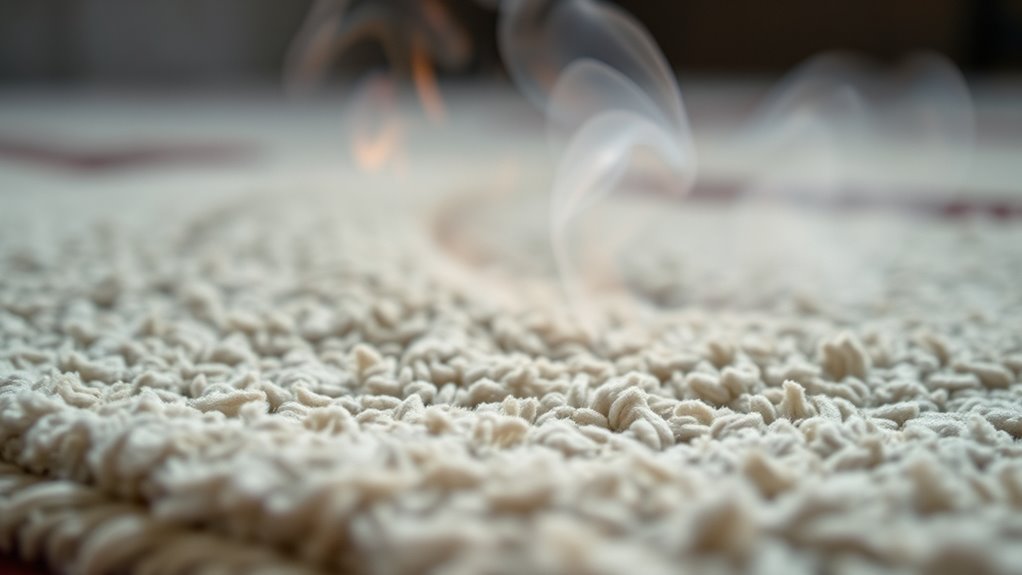
You might notice VOCs in your rug pad coming from manufacturing chemicals or the materials used. The type of materials and how they’re processed can influence the amount of off-gassing you experience. Factors like material composition and exposure time play a big role in how long VOCs linger. Additionally, understanding inspirational quotes about fatherhood can remind us of the importance of nurturing and caring for our environment and loved ones.
Manufacturing Chemicals Used
Many rug pads contain manufacturing chemicals that release volatile organic compounds (VOCs) into indoor air. During production, adhesives, binders, and flame retardants are commonly used to improve durability and safety. These chemicals often include formaldehyde, benzene, and volatile solvents that evaporate over time. Manufacturing processes sometimes involve the use of petroleum-based products, which can emit VOCs long after the rug pad is installed. Even if labels claim the product is “chemical-free,” traces of manufacturing chemicals may still be present. The VOCs released from these chemicals can linger in your home, contributing to indoor air pollution and potential health issues. Understanding these chemicals helps you recognize the importance of choosing low-VOC or VOC-free rug pads for healthier indoor environments. Additionally, some manufacturing chemicals are associated with high emissions of VOCs, which can exacerbate indoor air quality concerns over time.
Material Composition Variations
Different materials used in rug pads can be significant sources of VOC emissions, especially when synthetic or chemical-intensive components are involved. Many rug pads contain foam, rubber, or adhesives that release VOCs over time. For example, polyurethane foam often contains volatile solvents used during manufacturing, which slowly off-gas after installation. Rubber-based pads made from synthetic materials can emit VOCs like styrene or benzene derivatives. Additionally, adhesives used to bond layers or attach the pad to the rug may contain formaldehyde or other chemicals that contribute to off-gassing. Natural materials like felt or wool tend to emit fewer VOCs, but synthetic blends increase the potential for long-term chemical release. Understanding the material composition helps you choose options that minimize VOC exposure and improve indoor air quality. Material safety considerations are essential when selecting rug pads to ensure healthier indoor environments.
Off-Gassing Duration Factors
The duration of off-gassing from rug pads depends largely on their material composition and manufacturing processes. If your rug pad is made from synthetic materials like PVC or rubber, VOC emissions tend to last longer because these substances release chemicals slowly over time. Conversely, natural materials such as felt or rubber often off-gas for a shorter period. Manufacturing methods also matter; if chemical treatments or adhesives are used during production, off-gassing can extend well beyond initial use. Proper curing and ventilation during manufacturing can reduce VOC levels, but residual emissions may still persist. Factors like temperature, humidity, and exposure to sunlight also influence how long VOCs linger. To minimize exposure, choose rug pads with low-emission certifications and allow your rug to air out before use. Additionally, selecting low-emission materials can significantly reduce the duration and intensity of VOC off-gassing.
The Off-Gassing Process Over Time
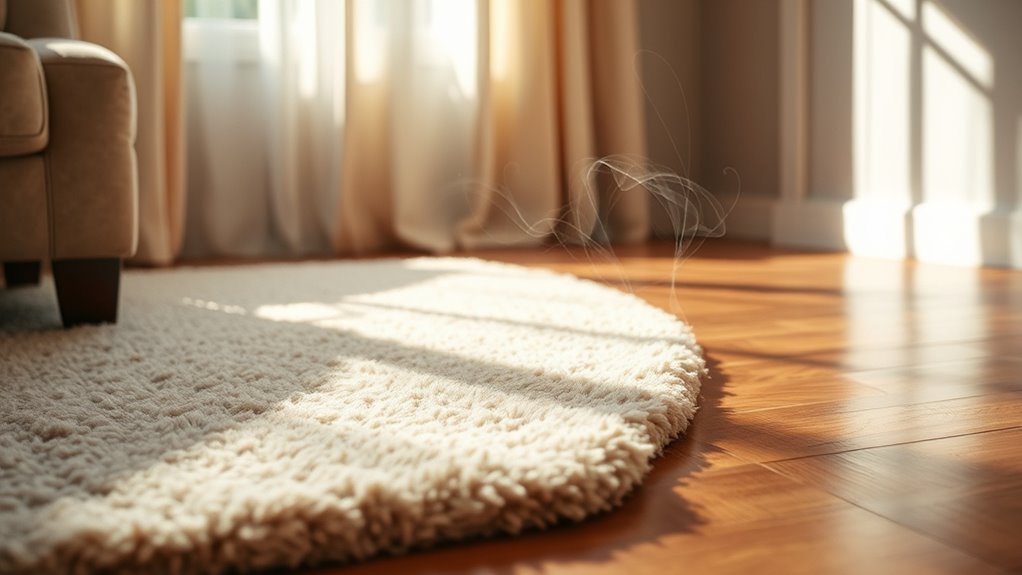
Initially, off-gassing from rug pads is most intense right after unrolling or installing them, as volatile organic compounds (VOCs) rapidly release into the air. During this period, you might notice a strong chemical smell. Over the next days or weeks, the emission rate decreases as the most volatile compounds escape. As time passes, VOC levels gradually decline, but some emissions can continue for months or even years, albeit at much lower levels. The process follows a pattern of rapid initial release followed by a slow, steady decline. This long-term off-gassing depends on factors like material composition and environmental conditions. Additionally, VOC emission rates can be influenced by temperature and humidity levels, affecting how long emissions persist. While the strongest odors fade quickly, low-level emissions can persist, meaning you might continue to detect faint chemical smells for an extended period.
Factors Influencing the Duration of VOC Emissions

Several factors influence how long VOC emissions from rug pads last, with material composition playing a primary role. Natural materials like wool or rubber tend to emit fewer VOCs and for shorter periods, while synthetic materials such as polyurethane or PVC often release VOCs longer due to their chemical makeup. Manufacturing processes also matter; poorly produced pads may contain residual chemicals that off-gas over extended periods. Thickness and density of the pad affect emission duration—thicker or denser pads can trap VOCs longer, prolonging off-gassing. Storage conditions matter too; exposure to heat, sunlight, or moisture can accelerate VOC release. Overall, choosing high-quality, natural, and properly manufactured rug pads can substantially reduce how long you experience VOC emissions. Additionally, selecting sustainable manufacturing practices can further minimize VOC emissions and environmental impact.
Health Risks Associated With Long-Term VOC Exposure
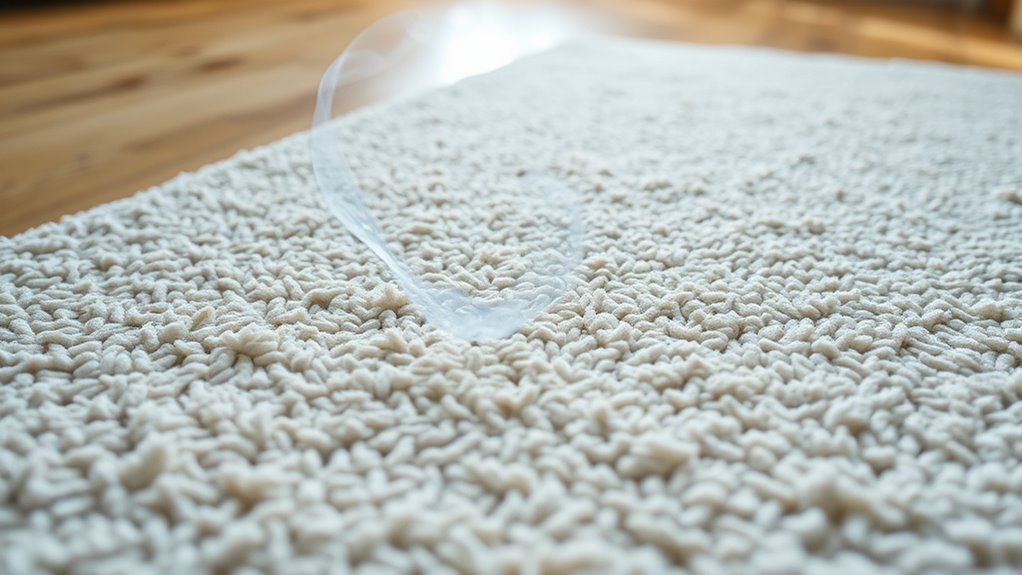
Long-term exposure to VOCs emitted from rug pads can pose significant health risks, especially for sensitive populations. Prolonged inhalation of these chemicals may cause respiratory issues, such as asthma or irritation of your airways. Some VOCs are linked to headaches, dizziness, and fatigue, reducing your overall well-being. Certain compounds are known to be carcinogenic or neurotoxic, increasing your long-term health risks. Children, the elderly, and those with pre-existing health conditions are particularly vulnerable. Continuous exposure can also weaken your immune system and contribute to allergic reactions. To protect yourself, it’s important to minimize VOC exposure by choosing low-emission rug pads or increasing ventilation in your home. Additionally, understanding the air purification technology in your home can help reduce indoor pollutants. Staying aware of these risks helps you make safer choices for your health.
Identifying Signs of VOC Off-Gassing in Your Home
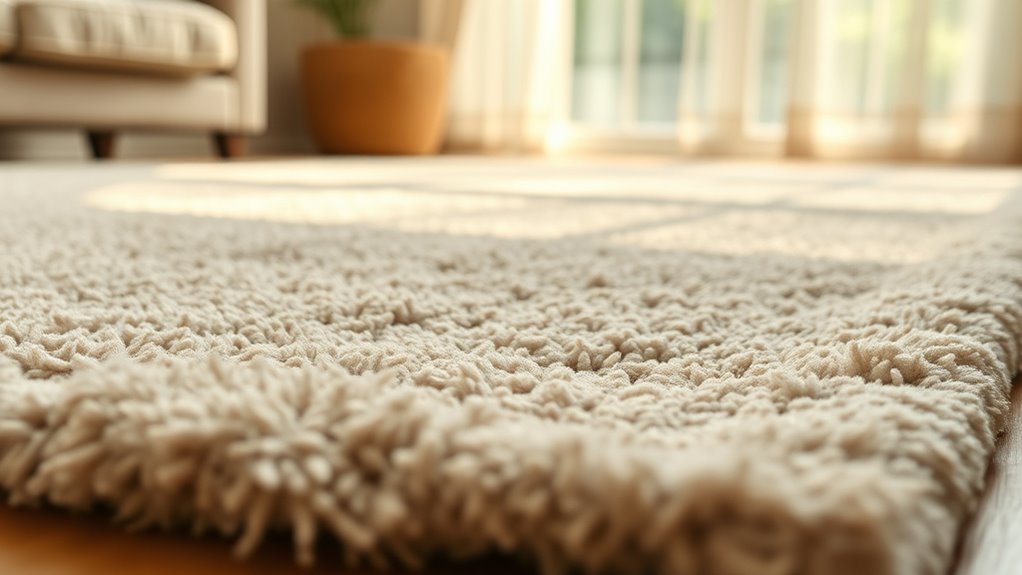
You might notice strange odors lingering in your home, especially after installing new rug pads. Respiratory irritation, such as coughing or sore throats, can also be signs of VOC off-gassing. If a chemical smell persists despite ventilation, it could indicate ongoing emissions from VOCs. Additionally, understanding resources and tools available can help you identify and mitigate these emissions effectively.
Recognizing Unusual Odors
Unusual odors are often the first warning sign that VOCs are off-gassing from your rug pad. If you notice a persistent chemical smell, especially when entering a room or near your rug, it’s a good indicator that VOCs may be present. These odors can range from a faint chemical scent to a strong, pungent smell that lingers. Pay attention to when the smell is most noticeable—new rug pads or recent installations often produce stronger odors. Keep in mind that VOC smells may not always be obvious; some off-gassing odors are subtle or masked by other scents. Trust your nose—if something smells unusual or chemical-like, it’s worth investigating further to determine if VOCs are affecting your indoor air quality. Additionally, understanding air quality concerns related to VOCs can help you take appropriate measures to improve your indoor environment.
Respiratory Irritation Signs
Respiratory irritation is a common early sign that VOCs are off-gassing from your rug pad. You might notice a persistent cough, sneezing, or a scratchy throat shortly after bringing new rugs or padding into your home. Some people experience more frequent or severe asthma symptoms, like wheezing or shortness of breath. These symptoms often worsen when you’re in the room with the rug or carpet, especially if ventilation is poor. You may also notice increased nasal congestion or irritation of the sinuses. If you find yourself coughing or experiencing breathing issues without other clear causes, VOC off-gassing could be the culprit. Pay attention to these signs, especially in new or recently renovated spaces, to identify potential VOC exposure early.
Lingering Chemical Smell
Have you noticed a persistent chemical smell lingering in your home after bringing in new rugs or padding? That strong, pungent odor is often a sign of VOCs off-gassing from the materials. You might detect it more intensely near the rug, pad, or furniture. This smell can vary in strength and duration, sometimes lasting for weeks or even months. If the odor is noticeable, it indicates that VOCs are actively releasing into your indoor air. While some smells fade over time, a persistent chemical scent suggests ongoing off-gassing. It’s important to pay attention to this sign because prolonged exposure can impact your health. Ventilating the space and using air purifiers can help reduce the smell and VOC levels over time.
Materials and Manufacturing Practices That Reduce VOCs
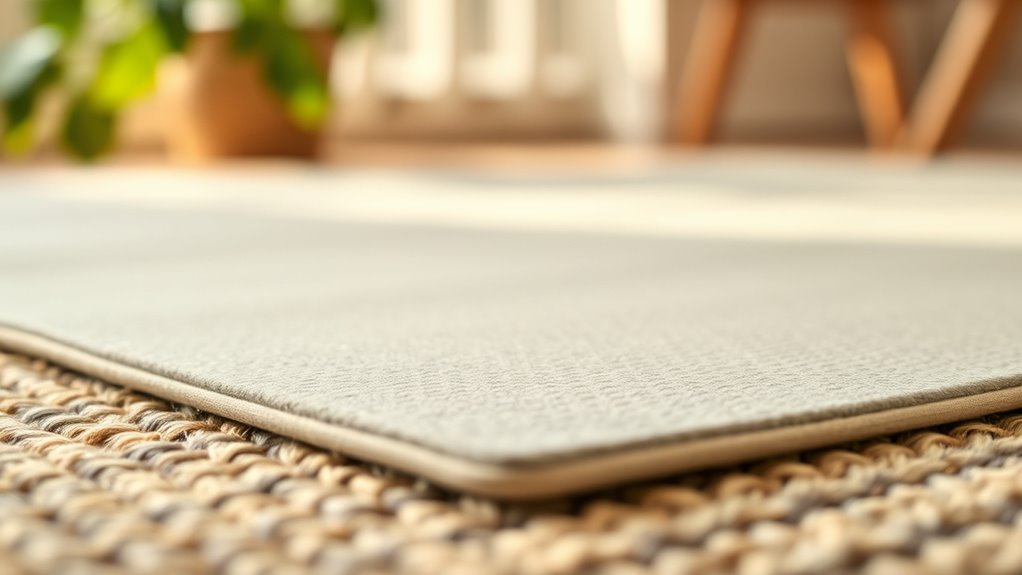
Choosing materials and manufacturing practices that minimize VOC emissions is essential for creating safer rug pads. Opt for natural, non-toxic materials like wool, cotton, or natural rubber, which generally release fewer volatile chemicals. Look for certifications such as GreenGuard or OEKO-TEX, indicating low chemical emissions. Manufacturers that avoid the use of adhesives containing formaldehyde or other harmful solvents also reduce VOC levels. Using production methods that limit chemical processing, such as mechanical bonding instead of chemical glues, further cuts VOC emissions. Selecting suppliers committed to sustainable, chemical-free practices ensures better indoor air quality. By prioritizing these materials and methods, you can considerably reduce the long-term off-gassing potential of your rug pads, creating a healthier environment in your home.
Strategies for Minimizing Long-Term Off-Gassing
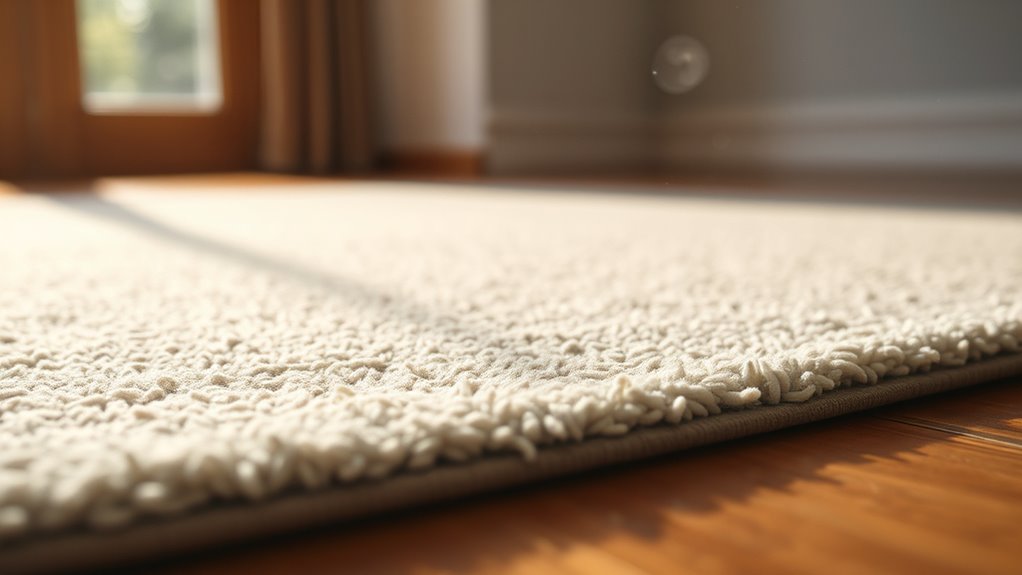
To minimize long-term off-gassing from rug pads, it’s essential to implement proactive maintenance and proper usage practices. First, regularly air out your rug and pad by removing them from the floor and exposing them to fresh air. This helps dissipate any trapped VOCs. Keep your space well-ventilated, especially during the first few weeks after installation, to facilitate VOC dispersal. Use a dehumidifier or air purifier with activated carbon filters to absorb airborne VOCs. Avoid placing rugs in direct sunlight or high-temperature areas, as heat can accelerate off-gassing. Additionally, clean your rug and pad with a damp cloth using non-toxic, low-VOC cleaning products. These habits reduce VOC buildup over time and promote a healthier indoor environment.
Choosing Low-Emission Rug Pads and Alternatives
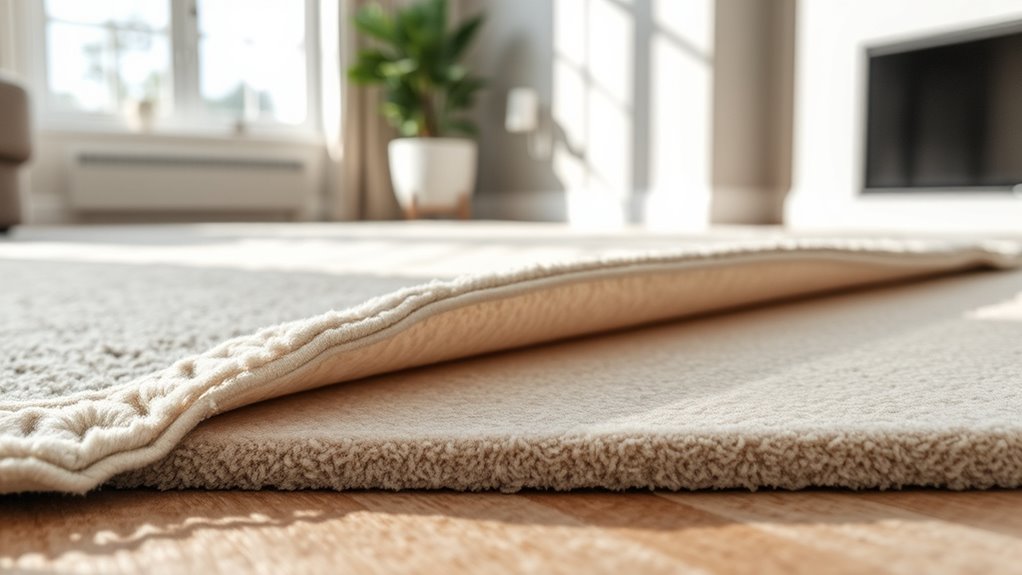
Opting for low-emission rug pads is one of the most effective ways to reduce indoor VOC levels. Look for pads made from natural materials like wool, felt, or rubber, which typically emit fewer chemicals. Always check product labels for certifications such as GreenGuard or OEKO-TEX, indicating lower VOC emissions. When selecting alternatives, consider options like double-sided tape or non-slip pads that don’t contain adhesives or synthetic compounds. Here’s a quick comparison:
| Material | Emission Level | Sustainability |
|---|---|---|
| Natural Wool | Low | Highly sustainable |
| Synthetic Foam | High | Less sustainable |
| Natural Rubber | Low | Sustainable |
Choosing wisely helps improve indoor air quality and minimizes health risks associated with VOCs.
Maintaining Indoor Air Quality When Using Rug Pads

Maintaining indoor air quality when using rug pads requires consistent ventilation and careful monitoring of air sources. Regularly open windows and use fans to circulate fresh air, helping to disperse VOCs that off-gas from the rug pad. Keep an eye on humidity levels, as high moisture can increase VOC emissions and promote mold growth. Avoid placing rugs in areas with poor airflow or near sources of fumes like cleaning products, paints, or new furniture. Use air purifiers with activated carbon filters to reduce VOC concentrations. Periodically check for signs of VOC buildup, such as odors or headaches. By maintaining good airflow and minimizing VOC sources, you can create a healthier indoor environment and reduce potential health risks associated with rug pad off-gassing.
Frequently Asked Questions
How Can I Test My Rug Pad for VOC Emissions?
If you want to test your rug pad for VOC emissions, start by choosing a reliable indoor air quality test kit designed for VOC detection. Follow the manufacturer’s instructions carefully, which usually involve placing a sampler near the rug pad for a specified time. Once the test is complete, send it to a lab or use a home kit to analyze the results. This helps you determine if the VOC levels are safe.
Are Natural or Organic Rug Pads Free From VOCS?
You might think natural or organic rug pads are completely VOC-free, but that’s not always true. While they generally emit fewer chemicals, some still contain adhesives or other additives that release VOCs over time. To be sure, look for products labeled as low-VOC or tested by third-party labs. Choosing certified organic options can also reduce your exposure, giving you peace of mind without sacrificing quality.
Can Air Purifiers Effectively Reduce VOC Levels From Rug Pads?
Air purifiers can help reduce VOC levels from rug pads, but their effectiveness depends on the device and room size. Look for purifiers with activated carbon filters, as they absorb VOCs better. Keep windows open for fresh air, and choose rug pads labeled low-VOC or VOC-free to minimize off-gassing. Regularly ventilating your space guarantees you breathe cleaner air and reduces VOC buildup over time.
Do All Rug Pad Materials Emit VOCS at Some Point?
Think of rug pad materials as silent singers; some hum with VOCs from the moment they’re laid down, while others remain quiet for years. Not all emit VOCs at the same rate or intensity. Natural materials like rubber or wool generally stay low, but synthetic options might release VOCs sooner or longer. So, you should always check labels and choose wisely to keep your indoor air fresh and safe.
What Are the Best Practices for Ventilating a Room With New Rug Pads?
When ventilating a room with new rug pads, you should open windows and doors to promote airflow. Use fans to enhance circulation and consider running an air purifier with a VOC filter. Keep the room well-ventilated for at least 48 hours, especially if you notice any strong odors. Regularly airing out the space helps reduce VOC concentrations, making the environment safer and more comfortable.
Conclusion
To protect your health, to improve your indoor air, and to guarantee your space feels fresh, choose low-emission rug pads, prioritize quality materials, and stay informed about VOCs. By understanding the sources, recognizing the risks, and adopting mindful practices, you can minimize off-gassing, reduce exposure, and create a healthier environment. Ultimately, making conscious choices, staying vigilant, and maintaining your space will help you breathe easier and enjoy a safer, more comfortable home.
